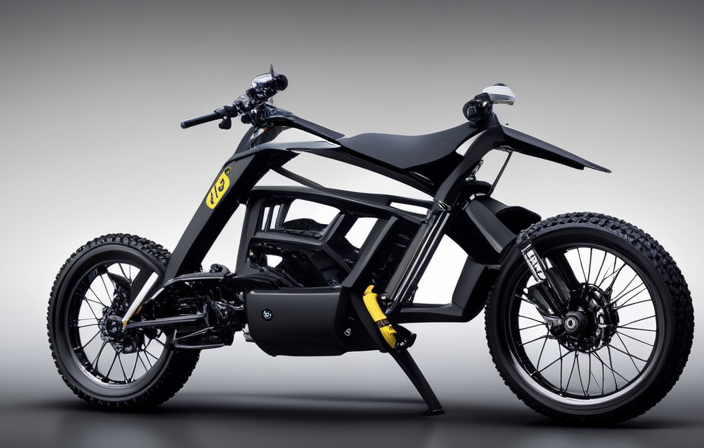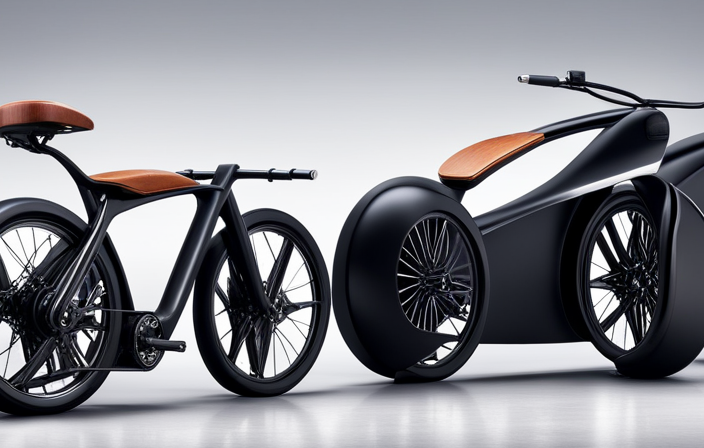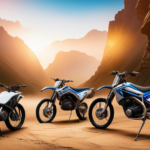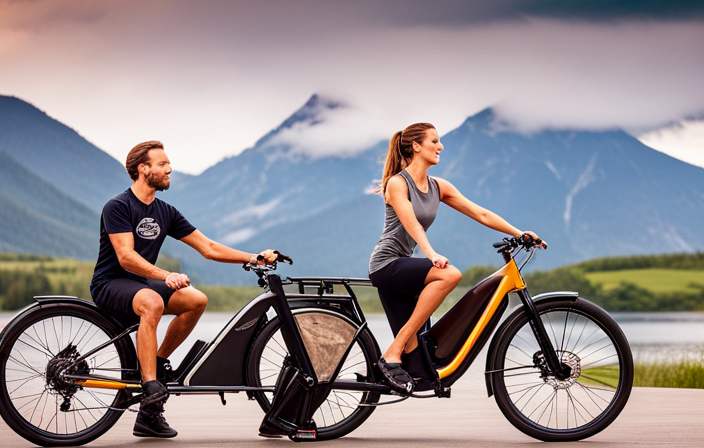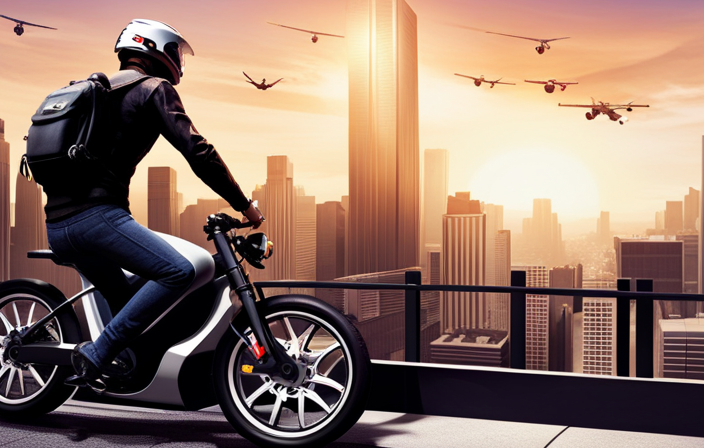As an avid dirt bike fan, I have been contemplating the timeless question: what distinguishes a gas dirt bike from an electric one?
To quench my curiosity, I delved into a comprehensive comparison of these two powerhouses. From the power source and performance to maintenance requirements and environmental impact, there are numerous factors to consider.
So, let’s dive in and explore the world of dirt bikes, shedding light on the key differences between gas and electric models.
Key Takeaways
- Gas dirt bikes rely on internal combustion engines and fuel combustion for power, while electric bikes have high-performance electric motors for instant torque and acceleration.
- Electric bikes produce zero emissions, while gas dirt bikes emit harmful pollutants.
- Electric bikes have fewer moving parts and require less maintenance compared to gas dirt bikes.
- Gas dirt bikes have higher speeds and power output, while electric bikes offer quick acceleration and responsive handling.
Power Source Comparison
If you’re looking for a dirt bike with a powerful and reliable power source, an electric bike might be the better option for you. When it comes to performance comparison, electric bikes have made significant advancements in recent years. They are equipped with high-performance electric motors that provide instant torque, delivering impressive acceleration and power.
On the other hand, gas dirt bikes rely on internal combustion engines that require fuel combustion to generate power.
In terms of environmental impact analysis, electric bikes have a clear advantage. They produce zero emissions during operation, contributing to a cleaner and greener environment. Gas dirt bikes, on the other hand, emit harmful pollutants such as carbon monoxide and nitrogen oxides, which contribute to air pollution and climate change.
Transitioning into the next section on performance and speed, it is important to note that electric bikes have come a long way in terms of their capabilities. While they may not match the top speeds of gas dirt bikes, electric bikes can still reach impressive speeds and offer a thrilling riding experience. Additionally, electric bikes have the advantage of instant torque, providing quick acceleration and responsive handling.
Now, let’s delve further into the performance and speed aspects of these two types of bikes.
Performance and Speed
The gas dirt bike can reach higher speeds than the electric bike primarily due to the difference in power output between the two types of bikes. Gas dirt bikes are typically equipped with powerful engines that can generate a significant amount of horsepower. This allows them to achieve faster speeds and tackle more challenging terrains. On the other hand, electric bikes rely on electric motors that have lower power output compared to gas engines. As a result, their acceleration capabilities and top speeds are relatively lower.
Gas dirt bikes are known for their quick acceleration and ability to reach higher speeds in a shorter amount of time. They have a higher power-to-weight ratio, allowing riders to experience a thrilling and adrenaline-pumping ride. Electric bikes, while quieter and more environmentally friendly, may lack the same level of power and speed that gas dirt bikes offer.
Transitioning to the next section about maintenance requirements, it is important to note that the performance and speed of a dirt bike can be affected by its overall condition and regular maintenance.
Maintenance Requirements
Transitioning to maintenance requirements, it’s crucial to keep dirt bikes in good condition through regular upkeep. As an avid dirt bike rider, I understand the importance of maintaining my bike to ensure optimal performance and longevity. Here are three key maintenance aspects to consider when taking care of your dirt bike:
-
Power Consumption: Dirt bikes, especially electric ones, rely on battery power to operate. It’s essential to monitor the power consumption of your bike and charge the battery as needed. Regularly checking the battery level and ensuring it is fully charged before each ride will prevent any power-related issues on the trails.
-
Battery Lifespan: The battery is the heart of an electric dirt bike. To extend its lifespan, it’s crucial to follow the manufacturer’s recommendations for charging and storage. Overcharging or leaving the battery depleted for extended periods can significantly reduce its overall lifespan. Proper care and maintenance will ensure a longer-lasting battery and uninterrupted riding experiences.
-
Regular Inspections: Regularly inspecting your dirt bike for any signs of wear and tear is essential. Check the brakes, chain, tires, and suspension components for proper functioning and adjust or replace them as necessary. Additionally, keeping your bike clean and free from dirt and debris will help prevent any potential damage to the electrical components or powertrain.
Transitioning now to the subsequent section about the environmental impact of dirt bikes, it’s important to consider how our riding habits can affect the world around us.
Environmental Impact
When considering the environmental impact of dirt biking, it’s crucial to be mindful of our riding practices and their potential consequences.
Dirt bikes, whether powered by gas or electricity, have an impact on the environment. Gas dirt bikes emit exhaust fumes that contribute to air pollution and greenhouse gas emissions. These emissions can have a negative effect on both human health and the environment. In response to these concerns, government regulations have been put in place to limit emissions from off-road vehicles, including dirt bikes. These regulations aim to reduce the environmental impact of dirt biking and promote cleaner technologies.
In contrast, electric dirt bikes have the potential to be more environmentally friendly. They produce zero emissions, eliminating the pollution associated with gas-powered bikes. However, it’s important to note that the production and disposal of batteries used in electric bikes can have their own environmental impact. It’s crucial to properly manage and recycle these batteries to minimize their harm.
Furthermore, when considering the environmental impact of dirt biking, it’s not just about emissions. Off-road performance also plays a role. A well-maintained and properly tuned dirt bike will have better fuel efficiency and emit fewer pollutants. It’s essential to follow proper maintenance procedures and use high-quality fuel to ensure optimal performance and minimize environmental impact.
Transitioning into the next section about cost factors, the environmental impact of dirt biking also has financial implications. The maintenance requirements and potential emissions of gas dirt bikes may result in higher costs compared to electric bikes.
Cost Factors
Considering the financial aspect, it’s worth noting that maintenance and potential emissions of gas-powered dirt bikes may lead to higher costs compared to their electric counterparts. When it comes to range comparison, electric dirt bikes generally have a shorter range than gas-powered ones. Gas bikes can travel longer distances on a full tank of fuel, while electric bikes usually have a limited battery range. This means that riders of electric dirt bikes may need to plan their routes more carefully, especially for longer rides.
In terms of cost of ownership, electric dirt bikes have several advantages. Firstly, they have fewer moving parts compared to gas bikes, which means there is less maintenance required. Additionally, the cost of electricity to charge the bike is typically lower than the cost of gasoline. This can result in significant savings over time. Furthermore, electric bikes are often eligible for government incentives and subsidies, further reducing the cost of ownership.
Transitioning into the next section about noise levels, it’s important to note that electric dirt bikes have a distinct advantage over their gas-powered counterparts in terms of noise pollution.
Noise Levels
When it comes to noise levels, there is a stark contrast between gas dirt bikes and electric bikes.
Gas dirt bikes are known for their loud engine noise, which can be quite disruptive to both the rider and those around them.
On the other hand, electric bikes offer a quiet and noise-free operation, providing a more peaceful and enjoyable riding experience for everyone involved.
Gas Dirt Bike – Loud Engine Noise
If you ride a gas dirt bike, you’ll definitely hear the loud engine noise. The power comparison between a gas dirt bike and an electric bike is quite significant. Gas dirt bikes are known for their raw power, providing a thrilling and adrenaline-pumping experience. The loud engine noise adds to the excitement, creating an immersive riding experience.
However, this power comes with an environmental impact. Gas dirt bikes emit harmful pollutants into the air, contributing to air pollution and climate change. Additionally, the noise pollution can be disruptive to both riders and those around them.
Transitioning into the subsequent section about electric bikes, it’s important to note that they offer a quiet and noise-free operation, providing a more peaceful and eco-friendly riding experience.
Electric Bike – Quiet and Noise-free Operation
Riding an electric bike is a peaceful experience with its quiet and noise-free operation. Unlike gas dirt bikes, which can be loud and disruptive, electric bikes provide a more serene and enjoyable ride. This is due to the power efficiency and advancements in battery technology.
Electric bikes are designed to maximize power output while minimizing energy waste, resulting in a highly efficient mode of transportation. The battery technology used in electric bikes has also significantly improved over the years, allowing for longer rides without the need for frequent recharging. With these advancements, electric bikes can now offer impressive range and shorter charging times, making them a practical option for daily commuting and recreational purposes.
Moving on to the next section, let’s explore the range and charging time of electric bikes.
Range and Charging Time
To maximize your riding time, consider an electric bike as they typically have a longer range and shorter charging time compared to gas dirt bikes.
Electric bikes are equipped with advanced lithium-ion batteries that offer impressive battery life, allowing you to ride for longer periods without the need for frequent recharging. Additionally, electric bikes are known for their efficiency, converting a higher percentage of energy into motion compared to gas dirt bikes, which tend to lose energy through heat and friction. This increased efficiency translates into a longer range, allowing you to explore more trails and cover greater distances on a single charge.
But that’s not all! Electric bikes also offer the convenience of shorter charging times. With fast-charging capabilities and advanced charging systems, electric bikes can be fully charged in a fraction of the time it takes to refuel a gas dirt bike. This means less time spent waiting and more time spent riding.
Transitioning into the next section on accessibility and availability, it’s important to note that the popularity of electric bikes is on the rise, leading to a wider range of options and increased availability in the market.
Accessibility and Availability
When comparing gas dirt bikes and electric bikes, one key difference lies in their accessibility and availability.
Gas dirt bikes are widely available, with numerous fuel stations catering to their needs.
On the other hand, electric bikes have limited availability, and the charging infrastructure is not as widespread or developed as fuel stations for gas bikes.
Gas Dirt Bike – Widespread Availability and Fuel Stations
If you’re considering a gas dirt bike, you’ll find that widespread availability and fuel stations make it convenient to fuel up and hit the trails. Gas dirt bikes are powered by a combustion engine, which provides a significant amount of power and allows for high performance and speed. These bikes are designed to deliver impressive acceleration and top speeds, making them ideal for adrenaline-seeking riders.
With a gas dirt bike, you have the freedom to explore various terrains without worrying about the limited range or charging times associated with electric bikes. However, as we transition into the subsequent section about electric bikes, it’s important to note that they have limited availability and rely on a charging infrastructure, which presents a different set of considerations for riders.
Electric Bike – Limited Availability and Charging Infrastructure
While electric bikes offer a more environmentally friendly option, their limited availability and reliance on a charging infrastructure can present challenges for potential riders.
When it comes to charging options, electric bikes typically require access to charging stations or outlets, which might not be as readily available as gas stations for traditional bikes. This limited availability can make it difficult for riders to find convenient places to charge their bikes, especially during long rides or in rural areas.
Additionally, battery life is a crucial factor to consider. Electric bikes have a limited range and require frequent charging, which can interrupt the riding experience and limit the distance that can be covered.
Despite these challenges, advancements in technology and the growing popularity of electric bikes are gradually improving charging options and extending battery life for a more seamless riding experience.
Riding Experience
When it comes to the riding experience, there are distinct differences between a gas dirt bike and an electric bike.
A gas dirt bike offers a traditional motorcycle feel with its powerful engine and manual transmission, providing riders with a raw and exhilarating experience.
On the other hand, an electric bike offers a smooth and silent ride, thanks to its electric motor, which eliminates the noise and vibrations associated with gas-powered engines.
Gas Dirt Bike – Traditional Motorcycle Feel
The gas dirt bike gives riders a more traditional motorcycle feel. With its powerful engine, it delivers an exhilarating ride that is unmatched by electric bikes. The engine power of a gas dirt bike allows for quick acceleration and higher top speeds, making it perfect for off-road adventures and motocross racing. To further highlight the differences between a gas dirt bike and an electric bike, let’s compare the engine power and battery life in a table:
| Gas Dirt Bike | Electric Bike | |
|---|---|---|
| Engine Power | High | Low |
| Battery Life | N/A | Limited |
As you can see, the gas dirt bike excels in engine power while the electric bike relies on its limited battery life. This transition ushers us into the next section, where we will explore the benefits of an electric bike – its smooth and silent ride.
Electric Bike – Smooth and Silent Ride
The electric bike offers riders a smooth and silent ride, providing a unique experience compared to its gas-powered counterpart. The electric motor delivers instant power, resulting in a seamless acceleration that enhances the riding experience.
Unlike a gas dirt bike, there is no engine noise or exhaust fumes, creating a quieter and more environmentally-friendly option. Safety considerations are also improved with an electric bike. The absence of a clutch and gears simplifies operation, making it easier for beginners to learn and reducing the risk of stalling. Additionally, the electric bike’s lower center of gravity enhances stability and control, increasing rider confidence.
Transitioning to the next section about durability and longevity, it is important to note that these factors contribute to the overall appeal and long-term value of electric bikes.
Durability and Longevity
One major difference between a gas dirt bike and an electric bike is their durability and longevity. When it comes to durability, gas dirt bikes are generally built tougher to handle rough terrains and withstand the demands of off-road riding. They are designed with sturdy frames, reinforced suspension, and robust engines that can endure high speeds and constant vibrations. On the other hand, electric bikes are known to have fewer moving parts and a simpler construction, making them less prone to mechanical issues. However, the batteries and electrical components of electric bikes can be susceptible to damage from impacts and extreme weather conditions.
In terms of longevity, gas dirt bikes require regular maintenance, such as oil changes and spark plug replacements, to keep them running smoothly and extend their lifespan. Electric bikes, on the other hand, have fewer maintenance requirements since they do not have internal combustion engines. However, the lifespan of an electric bike’s battery can vary depending on factors such as usage, charging habits, and the quality of the battery itself. It is important to note that the battery of an electric bike will eventually degrade over time and may need to be replaced.
To compare the durability and longevity of gas dirt bikes and electric bikes, let’s take a look at the following table:
| Durability | Longevity | |
|---|---|---|
| Gas Dirt Bike | Built tough with reinforced suspension and robust engines | Regular maintenance required for optimal performance |
| Electric Bike | Fewer moving parts and simpler construction | Battery lifespan depends on usage and charging habits |
Considering the durability and longevity factors, it is crucial to assess the specific needs and preferences of the rider when choosing between a gas dirt bike and an electric bike. Now let’s delve into the next section and explore the safety considerations when it comes to these two types of bikes.
Safety Considerations
When considering safety, it’s important to evaluate the potential risks and precautions associated with riding a gas dirt bike or an electric bike. Both types of bikes require careful attention to rider protection and the implementation of emergency response plans.
Rider protection is crucial when riding any type of bike, but there are some key differences between gas dirt bikes and electric bikes. Gas dirt bikes tend to be more powerful and faster, which means riders need to wear appropriate safety gear such as helmets, goggles, gloves, and protective clothing. Electric bikes, on the other hand, are generally quieter and have less power, but riders should still wear safety gear to protect themselves from potential falls or accidents.
Emergency response plans are also important for both types of bikes. Gas dirt bikes may pose a higher risk of fires or fuel leaks, so it’s important to have a plan in place to handle these situations. Electric bikes, although generally safer in terms of fire risks, still require proper maintenance and charging procedures to prevent accidents or malfunctions.
Transitioning into the next section about off-road performance, it’s clear that safety considerations play a crucial role in determining the overall performance and enjoyment of riding a gas dirt bike or an electric bike.
Off-road Performance
Transitioning into off-road performance, it’s clear that rider skill and terrain conditions greatly impact the overall enjoyment of riding a gas dirt bike or an electric bike. When it comes to off-road capabilities, both types of bikes have their strengths and weaknesses. Here are some key factors to consider:
-
Power delivery: Gas dirt bikes typically have more immediate power, allowing for quick acceleration and the ability to conquer steep inclines. Electric bikes, on the other hand, offer smooth and instant torque, providing excellent low-end power for technical terrain.
-
Weight: Gas dirt bikes tend to be heavier due to the engine and fuel tank. This can affect handling and maneuverability, especially in tight turns or when navigating through obstacles. Electric bikes, being lighter due to the absence of an engine, offer better agility and easier maneuvering.
-
Maintenance: Gas dirt bikes require regular maintenance, including oil changes, air filter cleaning, and spark plug replacements. Electric bikes have fewer moving parts, resulting in lower maintenance requirements and reduced costs.
-
Noise and emissions: Gas dirt bikes produce noise and emissions, which can be a concern in certain off-road areas. Electric bikes, on the other hand, operate silently and produce zero emissions, making them more environmentally friendly.
Considering these factors, it’s important for riders to assess their off-road needs and preferences to determine which type of bike would best suit their riding style.
As we move into the next section on government regulations, it’s crucial to understand how these regulations may affect the use of gas dirt bikes and electric bikes in off-road settings.
Government Regulations
To navigate through government regulations, you should familiarize yourself with the specific rules and restrictions that apply to off-road riding. When it comes to off-road vehicles, including dirt bikes, government regulations vary depending on the location and jurisdiction. These regulations are in place to ensure the safety of riders and protect the environment. Let’s take a look at a comparison between gas dirt bikes and electric bikes in terms of government regulations.
| Gas Dirt Bikes | Electric Bikes |
|---|---|
| – Typically louder due to the combustion engine | – Generally quieter due to electric motor |
| – Emissions from the combustion engine may be subject to stricter regulations | – Zero emissions, making them more environmentally friendly |
| – May require regular maintenance and tune-ups | – Requires less maintenance and fewer moving parts |
When it comes to government regulations, electric bikes often have an advantage over gas dirt bikes due to their quieter operation and zero emissions. In many areas, there are specific restrictions on noise levels and emissions, which electric bikes tend to comply with more easily. Additionally, electric bikes generally require less maintenance and have fewer moving parts, which can also be seen as a benefit when it comes to adhering to government regulations.
In the next section, we will delve into the community and culture surrounding off-road riding.
Community and Culture
The off-road riding community and culture is a vibrant and tight-knit group of enthusiasts who share a passion for exploring the outdoors on two wheels. Being part of this community not only provides endless opportunities for thrilling adventures, but also fosters a sense of community engagement and social impact.
Here are some key aspects that make the off-road riding community so special:
-
Supportive Network: The off-road riding community is known for its strong bonds and support system. Whether it’s offering advice on trails, sharing maintenance tips, or organizing group rides, riders are always there for each other.
-
Environmental Stewardship: Many off-road riders are passionate about preserving and protecting the natural environment. They actively engage in trail clean-up initiatives and promote responsible riding practices to minimize their impact on the ecosystem.
-
Advocacy and Education: The community actively advocates for off-road riding rights and educates others about the benefits of this recreational activity. They work towards promoting positive perceptions about off-road riding and dispelling misconceptions.
-
Charitable Initiatives: Off-road riders frequently organize charity events and fundraisers to give back to their communities. These initiatives showcase the community’s commitment to making a positive social impact beyond their love for riding.
-
Mentorship: Experienced riders often take new riders under their wing and provide guidance and mentorship. This helps newcomers learn the ropes, gain confidence, and become responsible riders.
Being part of the off-road riding community not only offers thrilling adventures but also provides numerous opportunities for community engagement and social impact. As riders, we understand the importance of preserving the environment, advocating for our rights, and giving back to the community.
Now, let’s dive into the next section and explore how personal preference and riding style play a significant role in choosing between a gas dirt bike and an electric bike.
Personal Preference and Riding Style
When it comes to choosing between a gas dirt bike and an electric bike, it all boils down to personal preference and how you like to ride. Both types of bikes have their own unique characteristics and advantages.
Gas dirt bikes are known for their powerful engines and high speeds, making them suitable for riders who enjoy off-road racing and adrenaline-filled adventures.
On the other hand, electric bikes are known for their quiet operation, low maintenance, and environmentally friendly nature. They are ideal for riders who prefer a more relaxed and eco-conscious riding experience.
When considering riding preferences, it’s important to think about the type of terrain you will be riding on.
Gas dirt bikes are generally better suited for rough and rugged terrains, such as dirt tracks and trails with challenging obstacles. The powerful engines of gas bikes provide the necessary torque and acceleration to handle these demanding terrains.
Electric bikes, on the other hand, are better suited for smoother and less demanding terrains, such as paved roads or light off-road trails. They may not have the same level of power as gas bikes, but they offer a smooth and controlled ride, making them perfect for casual riders or those who prefer a more relaxed riding experience.
Ultimately, the choice between a gas dirt bike and an electric bike depends on your personal preferences and riding style. Consider the type of riding you enjoy and the terrain you will be riding on to make an informed decision.
Frequently Asked Questions
Can a gas dirt bike be converted into an electric bike?
Yes, a gas dirt bike can be converted into an electric bike through a conversion process. The conversion involves removing the gas engine and replacing it with an electric motor and battery pack.
However, it is important to note that the conversion process can be complex and may require technical expertise.
Additionally, a cost analysis should be conducted to determine if the benefits of an electric bike outweigh the expenses involved in the conversion.
Are there any benefits to owning both a gas dirt bike and an electric bike?
Owning both a gas dirt bike and an electric bike can provide some unique benefits.
While the irony lies in the fact that they serve different purposes, the hybrid combination offers versatility.
Gas dirt bikes excel in power and endurance, perfect for long off-road adventures.
On the other hand, electric bikes are eco-friendly and cost-effective, ideal for short urban commutes.
Maintenance costs differ, with gas bikes requiring more frequent servicing and fuel expenses, while electric bikes have lower maintenance and charging costs.
Can an electric bike be ridden in the rain without any issues?
When it comes to riding an electric bike in the rain, there can be some issues to consider.
While electric bikes are generally designed to be weather-resistant, riding in heavy rain or submerging the bike in water can cause damage to the electrical components.
It is important to take precautions such as using fenders and covering the battery to prevent water damage.
Additionally, regular maintenance is necessary to ensure the bike’s longevity and performance, especially after riding in wet conditions.
Are there any special permits or licenses required to ride an electric bike?
Special permits or licenses are generally not required to ride an electric bike. Electric bikes are considered bicycles and are subject to the same rules and regulations as regular bicycles. However, it is important to check with local authorities as some jurisdictions may have specific regulations for electric bikes, such as speed limits or age restrictions.
In contrast, gas dirt bikes typically require special permits or licenses due to their higher speeds and engine power.
How do gas dirt bikes and electric bikes compare in terms of resale value?
When comparing the resale value of gas dirt bikes and electric bikes, there are several factors to consider.
One key factor is the growing popularity and demand for electric bikes, which can positively impact their resale value.
Additionally, the cost of gas to electric conversion can significantly impact the resale value of a gas dirt bike.
It’s important to note that individual bike conditions and market fluctuations can also influence the resale value comparison between gas dirt bikes and electric bikes.
Conclusion
After examining the various aspects of gas dirt bikes and electric bikes, it is clear that they each have their own unique qualities.
While gas dirt bikes roar like a mighty lion, electric bikes hum like a gentle breeze. They differ in power source, performance, maintenance, environmental impact, cost, and more.
Gas dirt bikes embrace the wild, untamed nature of off-road riding, while electric bikes provide a cleaner, quieter alternative.
Ultimately, the choice between the two depends on personal preference and riding style.
